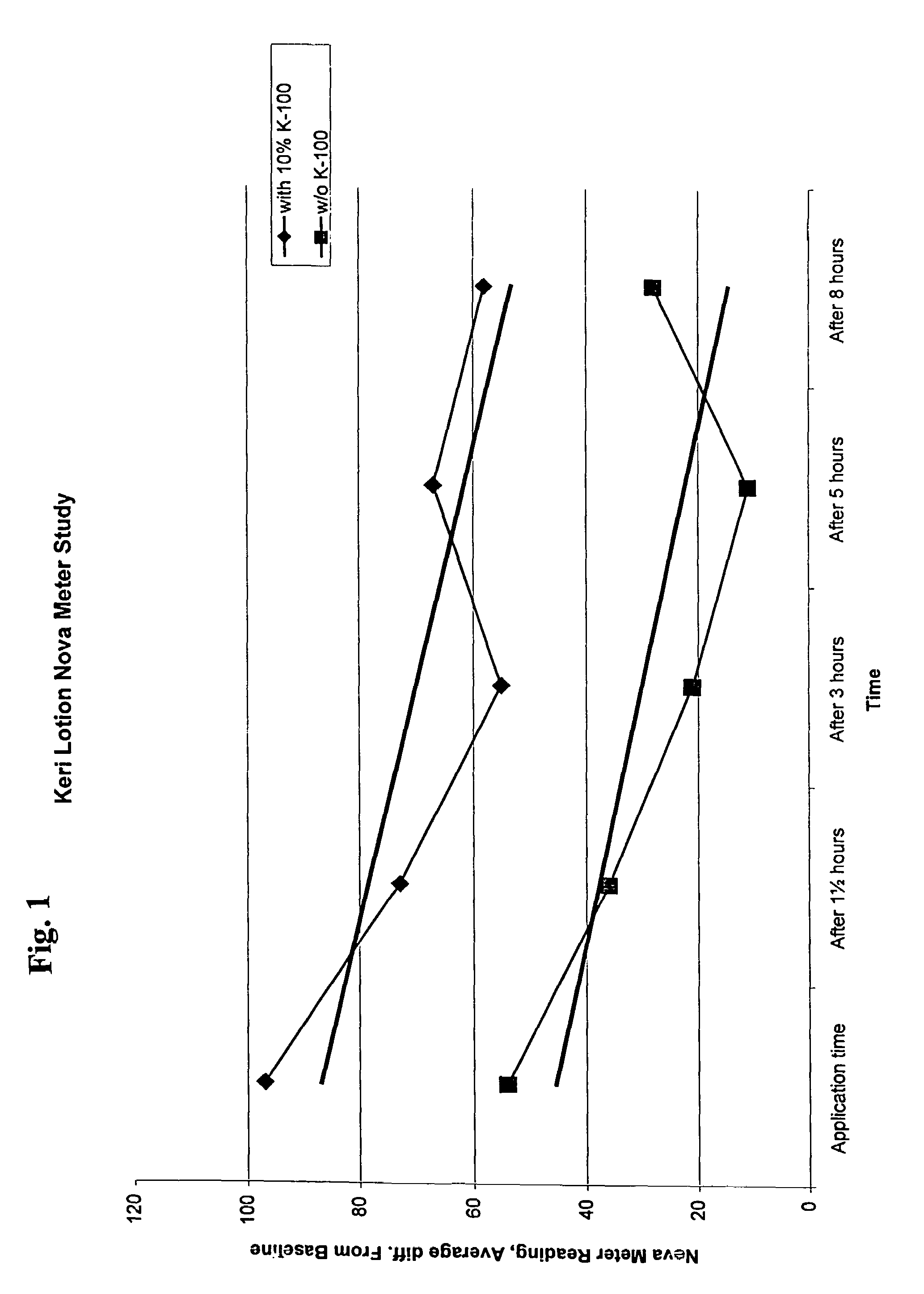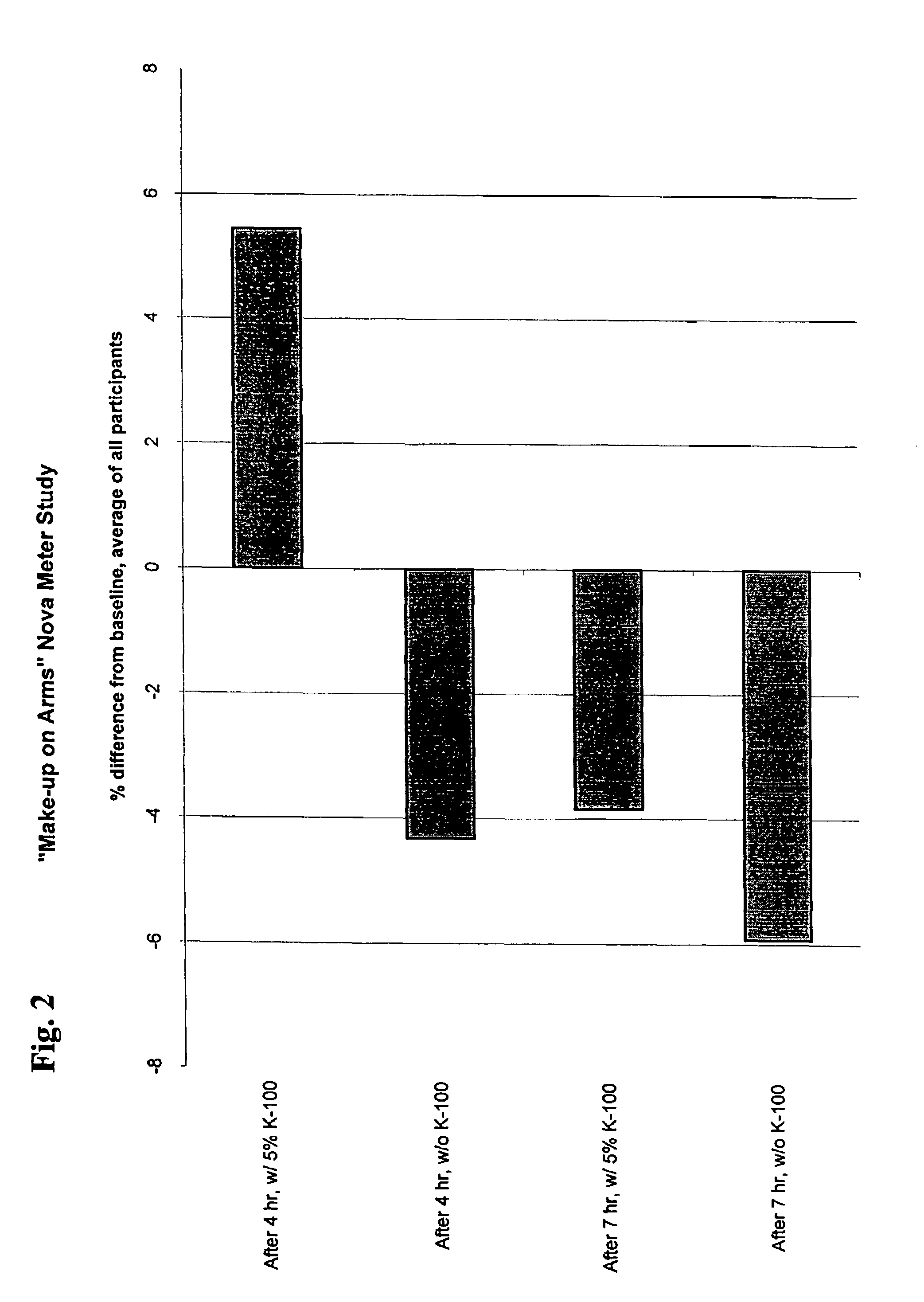High unsaponifiables and methods of using the same
a technology of unsaponifiables and carriers, applied in the field of new compositions of matter, can solve the problems of high unsaponifiables, insoluble for consumer use, unsuitable products, etc., and achieve the effects of preventing unwanted absorption of carried active ingredients, increasing water-solubility and surfactant activity, and high levels of aqueous surfactant activity
- Summary
- Abstract
- Description
- Claims
- Application Information
AI Technical Summary
Benefits of technology
Problems solved by technology
Method used
Image
Examples
example 1
Enhanced Skin Hydration
[0066]A Nova Meter is an impedance measuring device that is designed and commonly used to provide a non-invasive, objectively reproducible method of measurement for quantifying a biophysical character relative to hydration of the skin. Ten panelists participated in a skin hydration study that utilized a Nova Meter to register and record results. The test was conducted according to the following procedure.
[0067]A commercially available skin lotion was purchased and divided equally. Half was used as a control and half was used as a base into which 5% of a jojoba Hydrolysate was incorporated. The jojoba Hydrolysate was prepared according to the method disclosed in this invention. A baseline skin hydration reading was taken with the Nova Meter for each panelist in advance of any lotion application. The control and Hydrolysate containing lotions were applied to different areas of each panelist forearms. The Hydrolysate containing lotion was applied to the right for...
example 2
Reduces Dehydration
[0069]Two make-up formulas were prepared: a Hydrolysate formulation containing 5% of a Hydrolysate according to the present invention and a control formulation containing an extra 5% water. The 5% water was added to the control formulation to keep the remaining ingredient compositions the same between the two formulations. The control formulation was applied on the left forearm and the Hydrolysate formulation was applied on the right forearm.
[0070]A Nova Meter was used to take baseline hydration readings of each participant before make-up application and to take hydration readings at intervals of four and seven hours after application of each formulation. The results were averaged for each person using the control and Hydrolysate containing lotions to determine the percent difference in skin hydration from the baseline. The results are shown in FIG. 2.
[0071]At four hours after make-up application, the average Nova Meter readings of the participants showed an incre...
example 3
Enhanced Performance / Substantivity
[0074]Four different products for the treatment of fly abatement with animals, such as horses, were obtained. (Ceratex, Gnat-Away, Solitude, and Aqua-Pel.) Concentrated versions of these products were not available; therefore commercially available dilutions were used.
[0075]To each sample, either water or the Hydrolysate according to the present invention was added, to make a 10% Hydrolysate containing solution. All formulations were thoroughly mixed with a stirrer until homogeneous. All formulations were transferred into spray bottles.
[0076]Four horses were selected to participate. The left side of each horse was sprayed with the control formulation. The right side of each horse was sprayed with the Hydrolysate formulation. For eight (8) days, the number of flies on each horse's leg prior to re-application of any formulation was determined. With each of the four Hydrolysate formulations, the cumulative effect after eight days demonstrated a signifi...
PUM
| Property | Measurement | Unit |
|---|---|---|
| Fraction | aaaaa | aaaaa |
| Fraction | aaaaa | aaaaa |
| Fraction | aaaaa | aaaaa |
Abstract
Description
Claims
Application Information
 Login to View More
Login to View More - R&D
- Intellectual Property
- Life Sciences
- Materials
- Tech Scout
- Unparalleled Data Quality
- Higher Quality Content
- 60% Fewer Hallucinations
Browse by: Latest US Patents, China's latest patents, Technical Efficacy Thesaurus, Application Domain, Technology Topic, Popular Technical Reports.
© 2025 PatSnap. All rights reserved.Legal|Privacy policy|Modern Slavery Act Transparency Statement|Sitemap|About US| Contact US: help@patsnap.com



